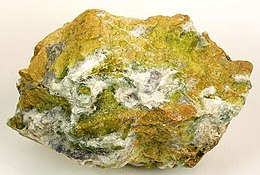
Back Hidrotalcita Catalan Hydrotalkit German Hidrotalquita Spanish Hidrotalcita EU Hydrotalcite French Hidrotalcit Croatian Hidrotalcit Hungarian Hidrotalsit ID Idrotalcite Italian ハイドロタルク石 Japanese
| Hydrotalcite | |
|---|---|
 | |
| General | |
| Category | Carbonate mineral |
| Formula (repeating unit) | Mg6Al2CO3(OH)16·4H2O |
| IMA symbol | Htc[1] |
| Strunz classification | 5.DA.50 |
| Crystal system | 3R polytype: Trigonal 2H polytype: Hexagonal |
| Crystal class | 3R polytype: Hexagonal scalenohedral (3m) H-M symbol: (3 2/m) 2H polytype: Dihexagonal dipyramidal (6/mmm) |
| Space group | R3m |
| Unit cell | a = 3.065 Å, c = 23.07 Å; Z = 3 |
| Identification | |
| Color | White with possible brownish tint |
| Crystal habit | Subhedral platey crystals, lamellar-fibrous, rarely euhedral prismatic; commonly foliated, massive |
| Cleavage | {0001}, perfect |
| Tenacity | Flexible, not elastic |
| Mohs scale hardness | 2 |
| Luster | Satiny to greasy or waxy |
| Streak | White |
| Diaphaneity | Transparent |
| Specific gravity | 2.03–2.09 |
| Optical properties | Uniaxial (−) |
| Refractive index | nω = 1.511 – 1.531 nε = 1.495 – 1.529 |
| Birefringence | δ = 0.016 |
| Other characteristics | Greasy feel |
| References | [2][3][4][5] |
Hydrotalcite, or formerly also völknerite,[6] is a layered double hydroxide (LDH) of general formula Mg
6Al
2CO
3(OH)
16·4H
2O, whose name is derived from its resemblance with talc and its high water content. Multiple structures containing loosely bound carbonate ions exist. The easily exchanged carbonates allow for applications of the mineral in wastewater treatment and nuclear fuel reprocessing.
- ^ Warr, L.N. (2021). "IMA–CNMNC approved mineral symbols". Mineralogical Magazine. 85 (3): 291–320. Bibcode:2021MinM...85..291W. doi:10.1180/mgm.2021.43. S2CID 235729616.
- ^ Mindat.org
- ^ Handbook of Mineralogy
- ^ Webmineral data
- ^ "IMA Nomenclature Report" (PDF). Archived from the original (PDF) on 2013-05-24. Retrieved 2012-11-25.
- ^ Rammelsberg, C. (1856-05-01). "On völknerite or hydrotalkite, and the so-called steatite of Snarum". The London, Edinburgh, and Dublin Philosophical Magazine and Journal of Science. 11 (73): 405–407. doi:10.1080/14786445608642090. ISSN 1941-5982.